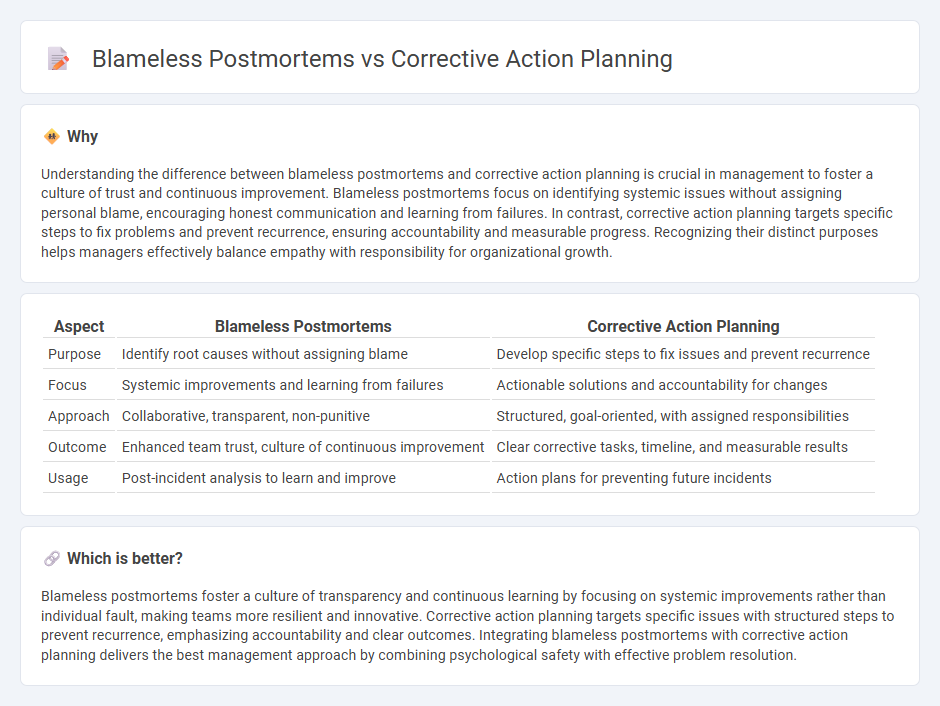
Blameless postmortems focus on understanding systemic failures without assigning individual blame, fostering a culture of transparency and continuous improvement. Corrective action planning targets specific issues by defining concrete steps to prevent recurrence and enhance accountability. Explore how integrating both approaches can elevate your organization's problem-solving effectiveness.
Why it is important
Understanding the difference between blameless postmortems and corrective action planning is crucial in management to foster a culture of trust and continuous improvement. Blameless postmortems focus on identifying systemic issues without assigning personal blame, encouraging honest communication and learning from failures. In contrast, corrective action planning targets specific steps to fix problems and prevent recurrence, ensuring accountability and measurable progress. Recognizing their distinct purposes helps managers effectively balance empathy with responsibility for organizational growth.
Comparison Table
| Aspect | Blameless Postmortems | Corrective Action Planning |
|---|---|---|
| Purpose | Identify root causes without assigning blame | Develop specific steps to fix issues and prevent recurrence |
| Focus | Systemic improvements and learning from failures | Actionable solutions and accountability for changes |
| Approach | Collaborative, transparent, non-punitive | Structured, goal-oriented, with assigned responsibilities |
| Outcome | Enhanced team trust, culture of continuous improvement | Clear corrective tasks, timeline, and measurable results |
| Usage | Post-incident analysis to learn and improve | Action plans for preventing future incidents |
Which is better?
Blameless postmortems foster a culture of transparency and continuous learning by focusing on systemic improvements rather than individual fault, making teams more resilient and innovative. Corrective action planning targets specific issues with structured steps to prevent recurrence, emphasizing accountability and clear outcomes. Integrating blameless postmortems with corrective action planning delivers the best management approach by combining psychological safety with effective problem resolution.
Connection
Blameless postmortems foster a culture of trust and transparency by focusing on system failures rather than individual mistakes, enabling teams to identify root causes effectively. Corrective action planning builds on these insights by developing targeted strategies that address underlying issues, preventing recurrence and improving overall process reliability. Together, they enhance organizational learning and drive continuous improvement in management practices.
Key Terms
Root Cause Analysis
Corrective action planning emphasizes identifying specific errors and implementing targeted fixes to prevent recurrence, often highlighting accountability to ensure corrective measures are followed. Blameless postmortems prioritize a transparent and non-punitive examination of incidents, fostering a culture of openness that enables deeper root cause analysis and systemic improvements. Explore how combining these approaches enhances organizational learning and resilience.
Accountability
Corrective action planning emphasizes assigning responsibility to specific individuals to address errors and prevent recurrence, fostering a culture of accountability through clear ownership of tasks. Blameless postmortems prioritize understanding systemic issues without attributing fault to individuals, encouraging transparency and learning within teams while maintaining collective responsibility. Explore the differences in accountability approaches between these methodologies to enhance your organization's incident management strategy.
Continuous Improvement
Corrective action planning targets specific issues by implementing structured solutions to prevent recurrence, emphasizing accountability and measurable outcomes. Blameless postmortems promote a culture of transparency and learning by analyzing failures without assigning fault, enhancing team collaboration and systemic improvements. Explore how integrating these approaches fosters sustainable continuous improvement in organizational processes.
Source and External Links
How to Create a Corrective Action Plan (With Template) - This guide provides a step-by-step process for creating a corrective action plan, including defining the problem, determining the root cause, and brainstorming corrective actions.
Corrective Action: Plan, Examples, and Process - This resource offers a comprehensive overview of corrective action plans, including how to identify issues, develop a plan, and implement corrective actions effectively.
Corrective Action Plan (CAP) Process - This presentation outlines the steps involved in creating a corrective action plan, focusing on identifying errors, determining root causes, and implementing cost-effective solutions.
 dowidth.com
dowidth.com